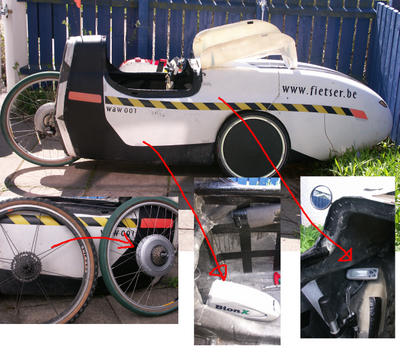Installment in the Waw + Test II

Installment
Installing the BionX in the Waw took a lot longer than 30 minutes. More like the better part of a whole day. Partly because Peter and I took some time to fix some other things. First issue to work out was if the BionX would fit with the standard-length electric wiring. Preferably I would have had the battery somewhere between the front wheels to have a lower centre of gravity and so improved stability, but that was not possible with the standard-length wires. The battery ended up under the seat, where it sits quite nicely between the rear wheel well and the seat. Because the battery holder usually sits on the bottle cage holder on a regular bicycle, the same mounting conditions were simulated using threaded rivets on the floor sandwich. Peter had to run of to the shop to get suitable longer bolts. Knowing the balance of the Waw when on two wheels, I noticed that the sideways stability was similar as before.
The console got a nice place on the top of the left wheel well, where it is very visible for the rider, yet out of direct sight for bystanders. Wire length was a perfect fit. Drilling the hole in the rear wall of the body to draw the power cable to the engine was the only scarring the Waw-body had to endure.
What had to be changed also was the gearing. The Waw001 originally had a 52/11-34 9-speed gearing. Now it is a 52/14-28 7-speed. That was a bit of a bummer to loose that much gearing range and to have to change the shifter from a high quality Rocket to a cheapo something gripshift. However, apparently a 7-speed 11-34 screw-on cassette exists too, so it is on order.
Test ride
The very first thing I noticed was that I could hear the hub engine, contrary to an instalment on the first test bicycle. And the sound seems to come from the front… so the light vibration makes the nosecone a loudspeaker – it actually sounds as the noise of a knobbly mountainbike tire at speed on a smooth asphalt road. There is also the slightest hint of a whining sound that is so typical for electrical motors – but that is very very weak. A little more riding showed that this vibration noise is only apparent on full 200% assist level. That is a relief. Pfew. It is nice to not notice the hub engine. Other than that, it works more or less like on the first bicycle test. I look forward to more extensive testing, very curious if it will get me into and back from Stockholm (a 50 km trip on rather hilly terrain) and how it influences my riding style.
For Peter however today is the first try-out and he is exited to see if it works for him. He takes the first steep ascent we know and… yep… he can manage it! And that with an awful gearing of 52/28 on a 26inch wheel. He has serious problems to manage the same on his 25kg lighter touring racer bicycle. Yep, the Waw is up to at least 40kg. What happens to be the weight of my old painted Alleweder and some other velomobiles without an assist engine….

0 Comments:
Post a Comment
<< Home